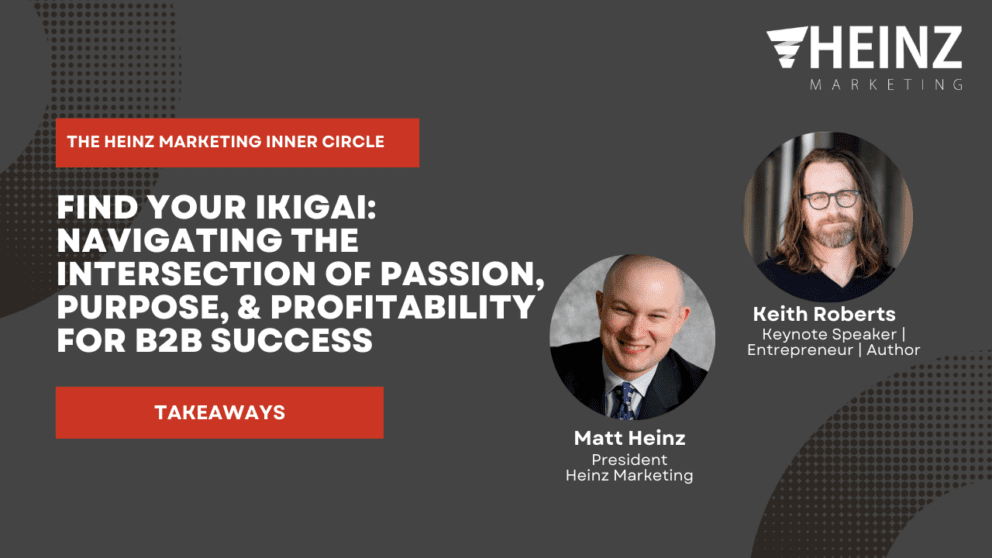5 Elements of a Successful Intent Data Strategy

Summary
The blog discusses the challenges of deploying intent data into marketing and sales initiatives and suggests a Crawl-Walk-Run approach for success. It emphasizes the importance of aligning the intent strategy with ABM initiatives and gaining buy-in from leadership to create a culture of collaboration between sales and marketing. The blog advises starting with a small pilot, collecting performance metrics, and integrating intent data with other systems to amplify results and achieve business scaling. The author offers a complimentary 30-minute consultation to help those struggling to see results with intent data.
By Payal Parikh, Director of Client Engagement at Heinz Marketing
Whether you are just getting started on an intent data journey, or if you are using it for a while and would like to see better results, keep reading…
Deploying intent data into marketing and sales initiatives can be challenging. Whether you are working with first-party, second-party, or third-party intent data. This is particularly because intent data can have a wide variety of use cases and can affect numerous systems and workflows.
This can in turn leave teams feeling overwhelmed and can make them resistant to the change.
However, if there is a sound strategy in place, it could carve a smooth path to success. Take a Crawl – Walk – Run approach.
Read more about the definitions of first-party, second-party, and third-party intent data here.
Align Intent Strategy with your ABM Initiatives
Deploying intent data without tying it to any initiative or program will not get you the results you want.
You can use intent data for ABM in different ways. Here are two specific use cases for account prioritization:
- Attach intent data to your current ICP definition. Which accounts are your target ideal customers and out of these, which accounts are showing intent? This will allow marketing to see accounts that are further down the funnel. And will provide sales reps with more relevant information so they can have meaningful conversations with those target accounts.
- Identify a segment of net new accounts that are showing intent but fall outside of your ICP. This is particularly useful for companies with a limited database. This use case will increase the sales pipeline and will also help define and modify your ICP criteria.
Get Buy-In and Align on Goals and Strategies
Leadership drives the attitudes of their teams. Any culture change starts with leadership for it to be effective. Get buy-in from the executives in your organization for the concept of bringing the teams together, to work towards a common goal. They need to understand the team should be working with each other and not in silos.
Creating a culture where sales and marketing combine their efforts to accomplish company goals isn’t out of reach. True alignment does not happen at the sales kick-off. It happens via the tactics, processes, and habits that connect the two groups daily.
Get the team on board with what you are trying to achieve with intent data. Share your strategy and set some measurable goals for both teams. Align on target accounts, follow-up strategy, and metrics.
Some of you have already tried using intent data within your organization. And you know that intent data is not just a technology, it is a culture change. Training is an important part of this shift. So, train early and train often.
Start With a Small Pilot
Roll out the intent data framework with a limited set of accounts to a limited group of sales team members within your organization. This could be a single region or a team that works on a particular set of accounts. Pick one that you can work closely with. This is important for making a couple of iterations in the approach and fine tune the strategy.
Pilot testing will allow you to streamline and document your processes. This will make it easier for launching intent data initiatives with other sales teams.
Think of pilot testing as a controlled group study. Test for some time and share results to get everyone on board. Let your internal teams be your advocate!
Read here about 4 ways you can leverage intent data in B2B marketing.
Collect Intel on Performance Metrics
Not a lot of companies think about performance metrics in advance. Collecting your conversion rates before rolling out the pilot test program will help you see the success of the pilot test.
Monitoring pilot program performance throughout is crucial for its success. Marketing and sales can set up a regular meeting cadence to go over the metrics, what’s working, and what’s not working. This is an important learning process before you roll out the initiative companywide.
Integrate With Other Systems
To amplify the results from intent data, think about how you can benefit from integrations with your other systems. It will increase ease of use and it will expand your ability to add more use cases.
For example, integrating with your CRM will help with increased visibility and performance through the funnel. It can also fuel your land and expand your strategy.
Taking an incremental and step-by-step approach to your intent data strategy is important for its success. Intent data can benefit different teams and departments within an organization, increase customer satisfaction, and also help your business scale quickly.
After all, you can’t boil the entire ocean.
I would love to hear about your approach to intent data. And if you are struggling to see results, let me know and we can set up a complimentary 30-minute consultation.





